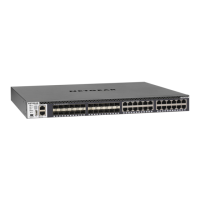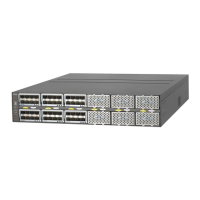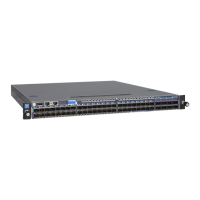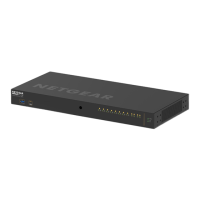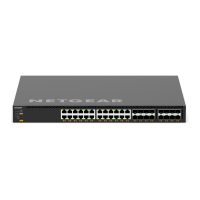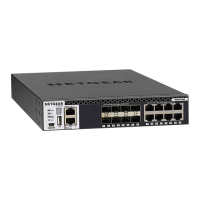Configuration Examples
443
M4100 Series Managed Switch
A MSTP bridge can be configured to behave entirely as a RSTP bridge or a STP bridge. So,
an IEEE 802.1s bridge inherently also supports IEEE 802.1w and IEEE 802.1D.
The MSTP algorithm and protocol provide simple and full connectivity for frames assigned to
any given VLAN throughout a bridged LAN comprising arbitrarily interconnected networking
devices, each operating MSTP, STP, or RSTP. MSTP allows frames assigned to different
VLANs to follow separate paths, each based on an independent Multiple Spanning Tree
Instance (MSTI), within Multiple Spanning Tree (MST) Regions composed of LANs and or
MSTP bridges. These regions and the other bridges and LANs are connected into a single
Common Spanning Tree (CST). (IEEE DRAFT P802.1s/D13)
MSTP connects all bridges and LANs with a single Common and Internal Spanning Tree
(CIST). The CIST supports the automatic determination of each MST region, choosing its
maximum possible extent. The connectivity calculated for the CIST provides the CST for
interconnecting these regions, and an Internal Spanning Tree (IST) within each region. MSTP
ensures that frames with a given VLAN ID are assigned to one and only one of the MSTIs or
the IST within the region, that the assignment is consistent among all the networking devices
in the region and that the stable connectivity of each MSTI and IST at the boundary of the
region matches that of the CST. The stable active topology of the bridged LAN with respect to
frames consistently classified as belonging to any given VLAN thus simply and fully connects
all LANs and networking devices throughout the network, though frames belonging to
different VLANs can take different paths within any Region, per IEEE DRAFT P802.1s/D13.
All bridges, whether they use STP, RSTP, or MSTP, send information in configuration
messages through bridge protocol data units (BPDUs) to assign port roles that determine
each port’s participation in a fully and simply connected active topology based on one or
more spanning trees. The information communicated is known as the spanning tree priority
vector. The BPDU structure for each of these different protocols is different. A MSTP bridge
transmits the appropriate BPDU depending on the received type of BPDU from a particular
port.
An MST region comprises one or more MSTP bridges with the same MST configuration
identifier, using the same MSTIs,and without any bridges attached that cannot receive and
transmit MSTP BPDUs. The MST configuration identifier has the following components:
1. Configuration identifier format selector
2. Configuration name
3. Configuration revision level
4. Configuration digest: 16-byte signature of type HMAC-MD5 created from the MST
Configuration Table (a VLAN ID to MSTID mapping)
As there are multiple instances of Spanning Tree, there is an MSTP state maintained on a
per-port, per-instance basis (or on a per-port, per-VLAN basis, as any VLAN can be in one
and only one MSTI or CIST). For example, port A can be forwarding for instance 1 while
discarding for instance 2. The port states changed since IEEE 802.1D specification.
To support multiple spanning trees, a MSTP bridge must be configured with an unambiguous
assignment of VLAN IDs (VIDs) to spanning trees. This is achieved by ensure the following:
1. The allocation of VIDs to FIDs is unambiguous.
2. Each FID supported by the bridge is allocated to exactly one spanning tree instance.
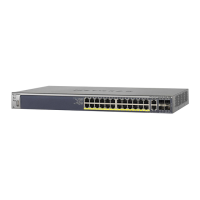
